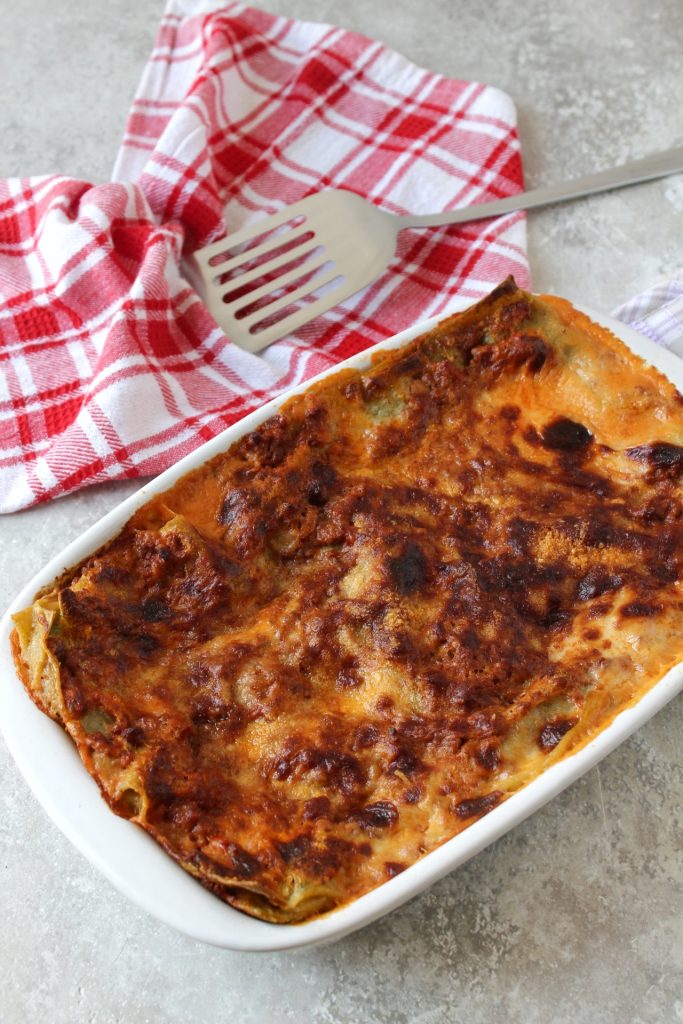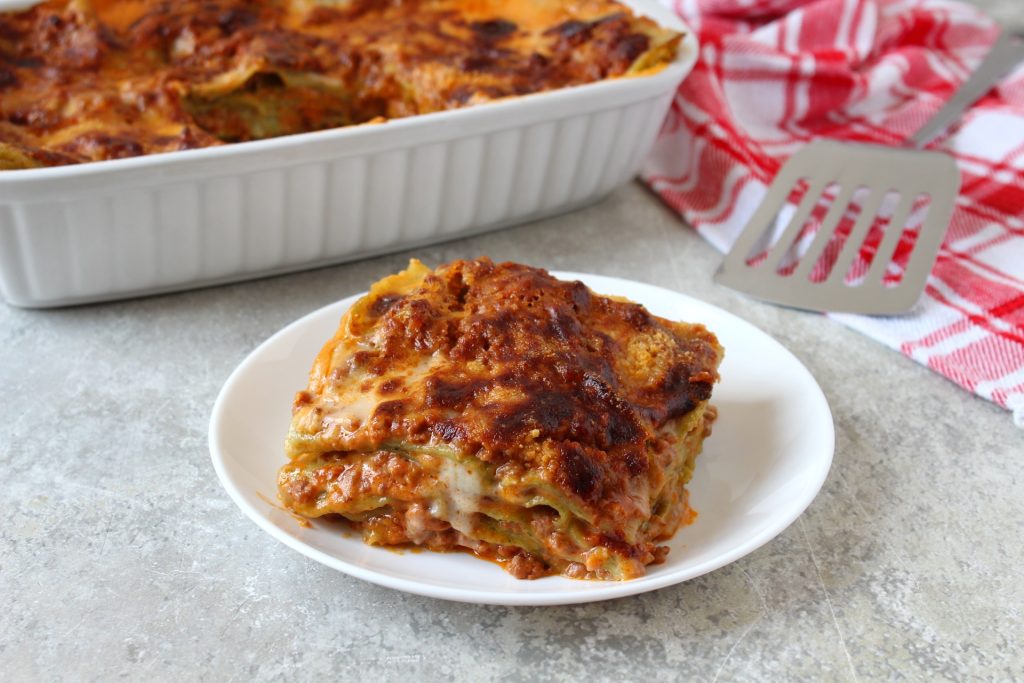I believe lasagna bolognese is one of the most famous dishes in Italy, and therefore everyone, even in Bologna itself, has their own recipe that they guard jealously, perhaps passed down through generations.
I have the advantage of being Bolognese, born in Bologna and lived there until my thirties; let’s say I’ve eaten enough lasagna to have my say 😉
Here I will share what I consider the most traditional recipe, which obviously must be based on an authentic Bolognese ragù, essential to give the true taste and flavor of lasagna bolognese.
Let me summarize the main features that distinguish true Bolognese lasagna from other lasagnas, which are delicious in every way!:
– as I mentioned, the true Bolognese ragù
– green spinach pasta
– strictly composed of seven layers
– the ragù and béchamel should be distributed separately, not mixed together before assembling the lasagna.
Did you know these little ‘rules’?
But now let’s move on to the RECIPE, before which you will also find the COMPLETE VIDEO, where in addition to assembling the lasagna, you will find all the steps, both for homemade béchamel and for preparing the true Bolognese ragù.
The only thing you won’t find below is the preparation of the green pasta, as it is the most complicated part, and in my opinion, it can be safely omitted by purchasing it from a fresh pasta shop or from the fresh pasta section in the supermarket.
I also leave you below a direct link to the sole recipe for the BOLOGNESE RAGU, so you can divide the preparation of the lasagna into two days, where on the first day you dedicate yourself to preparing the ragù (which will take about three hours) and the next day you can prepare the homemade béchamel (very quick!) and assemble the lasagna.

- Difficulty: Easy
- Cost: Medium
- Preparation time: 30 Minutes
- Portions: 6
- Cooking methods: Oven
- Cuisine: Italian
- Seasonality: Autumn, Winter, and Spring, Christmas
Ingredients for preparing LASAGNA BOLOGNESE
- 4 cups whole milk
- 7 tbsp butter
- 7 tbsp all-purpose flour
- to taste nutmeg
- to taste salt (about a teaspoon)
- 1.3 lbs ground beef
- 7 oz pancetta (bacon)
- 2 stalks celery
- 2 cups carrots (net of waste)
- 1 yellow onion (about 70-80 g)
- 2 cups tomato sauce (or pulp)
- 2 cups water (+ additional as needed during cooking)
- 1 tbsp tomato paste
- 1 glass red wine (of good quality)
- to taste salt
- 1.1 lbs Green egg lasagna (preferably fresh)
- 2.2 lbs béchamel (this is the weight if you buy it ready-made)
- Bolognese ragù (in the quantity obtained by following the recipe I indicated)
- 3.5 oz grated Parmesan cheese (of excellent quality)
Tools for preparing LASAGNA BOLOGNESE
- Baking dish 10×12 inches
- Hand whisk
Steps to prepare LASAGNA BOLOGNESE
In a medium saucepan, pour the milk and put it on the stove over medium heat, add a teaspoon of salt, a pinch of nutmeg, and leave it on the heat until the milk is warmed; make sure it doesn’t reach a boil.
Meanwhile, in a separate saucepan, melt the butter over low heat; once completely melted, add the flour all at once and quickly stir with a hand whisk until you have what’s called the ‘roux’, a thick, amber, and lump-free mixture that will form after about half a minute of whisking while keeping the heat low.
At this point, still with the burner on, pour a ladle of the warm milk you just prepared into the roux, stir quickly with the whisk, then pour all at once the remaining milk.
Continue to stir well with the whisk until your béchamel begins to thicken. The time it will take will depend greatly on the temperature of the milk you pour, but it will take approximately five minutes.
Achieve the consistency you see in the VIDEO, which should be fairly liquid, otherwise the lasagna will have trouble cooking properly.
As soon as you turn off the heat, pour the béchamel into a clean bowl, and keep it aside after covering it with plastic wrap.For preparing the Bolognese ragù, you will need about four hours, so I recommend preparing it the day before and keeping it in the fridge for the next day, or you can prepare it days in advance and freeze it; of course, when you use it to assemble the lasagna, you will need to bring it back to room temperature.
Here you will find the step-by-step Bolognese ragù recipe with the complete video of the single preparation: BOLOGNESE RAGU.
Take the rectangular baking dish, about 10×12 inches in size, and spread a layer of béchamel at the base.
Note:
– If you prepared the béchamel shortly before, it will be perfect because it’s still slightly warm, you just need to give it a vigorous stir to make it smooth and homogeneous again.
– If you prepared the béchamel the day before, you’ll need to bring it back to room temperature or slightly warm by putting it on the stove for a few minutes.
– If you use ready-made béchamel due to time constraints, warm it slightly and add milk until you get the right consistency, as the ready-made versions are usually too thick for lasagna preparation.
Start now to create the layers, which for a true Bolognese lasagna should be seven, but even if you make five or six, they’ll still be delicious 😉
Alternate a layer of green pasta, then more béchamel, ragù, grated Parmesan until reaching the last layer where I recommend being generous with both the ragù and Parmesan, which will create a wonderful crust during baking.
Bake in a preheated static oven on the middle rack at 350°F for about 40 minutes.
If the surface starts to darken too much halfway through cooking, continue baking covered with aluminum foil.
Once removed from the oven, allow 5-10 minutes before serving.
And here are your amazing LASAGNA BOLOGNESE!

Storage and Tips
Finding green pasta, if you don’t live in Bologna or nearby areas, is not impossible, but it isn’t that simple either. Despite not living in Bologna anymore, I still find them, even in well-stocked supermarkets; but if you can’t find them, you can replace them with classic egg lasagna, following the same steps, and you’ll still make a great impression!
Your lasagna bolognese can be frozen raw, well covered, and cooked without thawing when needed; or they can also be frozen cooked, reheating them without defrosting when needed.
You can also keep them in the refrigerator for 1-2 days at most.
You can also keep them in the refrigerator for 1-2 days at most.

